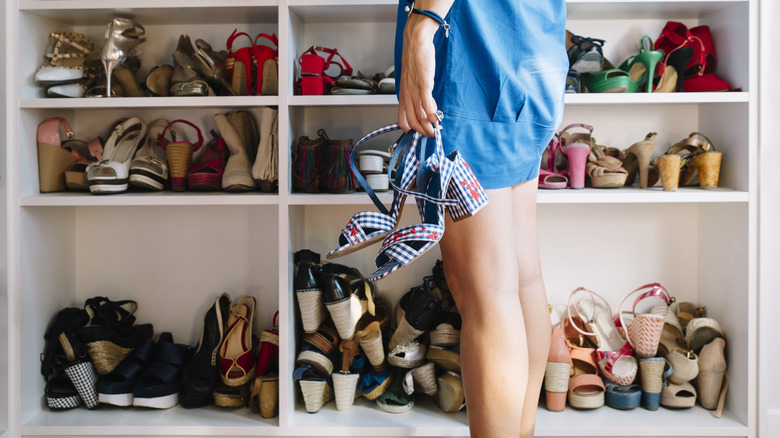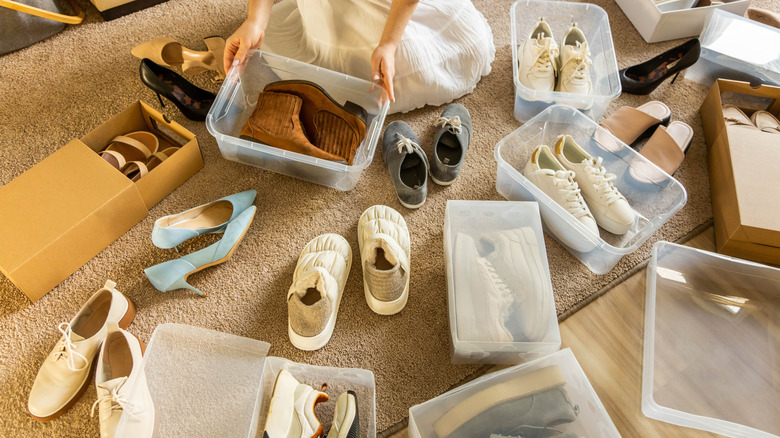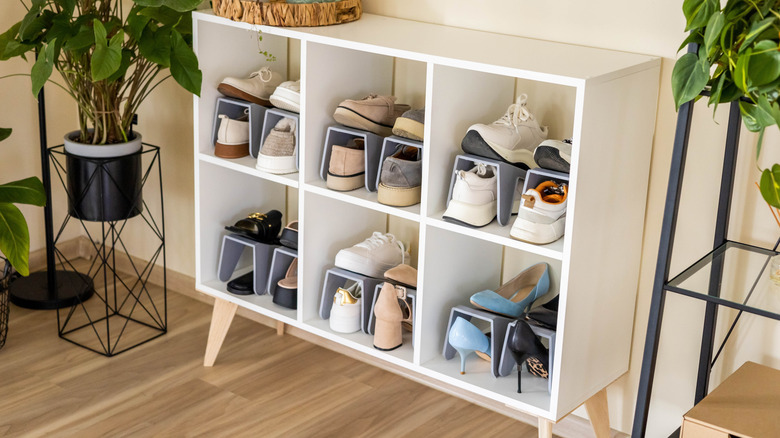The Disastrous Mistake You're Making While Organizing Shoes
Organizing shoes can sometimes be tricky, especially if you don't intend to use them for a while. In many cases, sealed plastic containers might seem like the best long-term solution, as they can help you protect your shoes from dust and critters. They also look neat when placed on a shelf or inside a closet. However, what you might not realize immediately is that lidded plastic boxes can be the worst containers for storing shoes. Not only do they trap moisture and promote mold growth, but they also prevent air circulation. While it might not seem like a big deal when you're storing your shoes for a couple of days, this disastrous mistake could cause your shoes to fall apart, peel, or rot if you intend to store them for months.
What's more is that plastic containers aren't always as airtight as you think, allowing for small pests to invade your boxes and destroy your shoes. And even if you do find an airtight container that doesn't trap moisture, this can still be catastrophic, especially for leather footwear. In the total absence of moisture, the oil in the leather will dry, causing the shoes to gradually degrade and crack. This is what we call dry rotting. Severe molding and dry rotting are often irreversible, which means that your shoes will no longer be usable.
Better options for storing and organizing shoes
To keep your belongings safe in long-term storage, location matters the most. Place your shoes in a dry, cool area with proper ventilation, like on a shelf or a shoe rack. Another important thing to keep in mind is that you don't want to keep your shoes on a shelf that gets hit by direct sunlight, as the UV rays can oxidize your shoes, causing yellowing or even cracking. Of course, you can always move lidded plastic shoe bins to a darker, cooler section of the closet. However, you also need storage with proper air circulation and low humidity, and that isn't always easy with these sealable containers.
Before storing your shoes, always ensure that they're clean and completely dry. If you live in a place with high humidity, keep a dehumidifier or a packet or two of silica gel with your shoes to remove excess moisture. You should also consider using cedar shoe trees to reduce moisture and retain the shape of your shoes. Be aware that leather shrinks over time for various reasons, and you'd need to readjust your shoe trees often. If you don't want to use shoe trees, you can also stuff your shoes with acid-free paper to help prevent dampness and odors. Don't use newspapers or colored paper, as leather can get permanently stained. If you own boots that you don't want to crease, use boot shapers. A final tip to keep in mind is that shoes are meant to be worn. By using your shoes occasionally, you prevent the glue from drying out and help keep the shoes' frames intact.
Best organizers for proper shoe storage
There are many genius shoes storage ideas that can help you organize your shoes elegantly without damaging them. If you want to avoid the issues lidded plastic bins create for shoes, the simplest and most logical solution is to store them directly on a shoe cube, a shoe rack, or an empty shelf. Because this can sometimes be challenging if you have limited room, using cabinet organizers or shoe slot organizers will help you stack multiple shoes on top of one another, providing them with proper airflow while saving you storage space. Another space-saving hack is using a tension rod to turn a cabinet into an organized shoe rack.
If you're worried about dust or insects, you can store your shoes inside breathable cotton bags, non-woven shoe bags, shoe boxes made of fabric, or shoe pouches. Another creative way to organize your shoes is by hanging woven baskets on a wall rack and keeping your shoes inside them. You can also use standing coat racks to hang your sneakers or platform shoes. Peg rails and hanging shoe organizers with pockets can help you save extra storage space as well.


